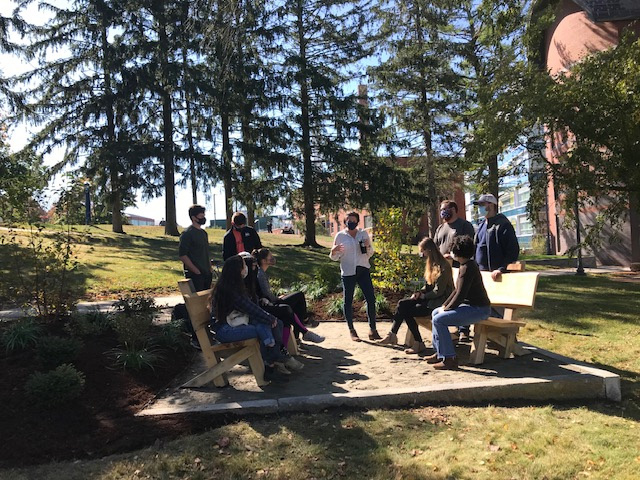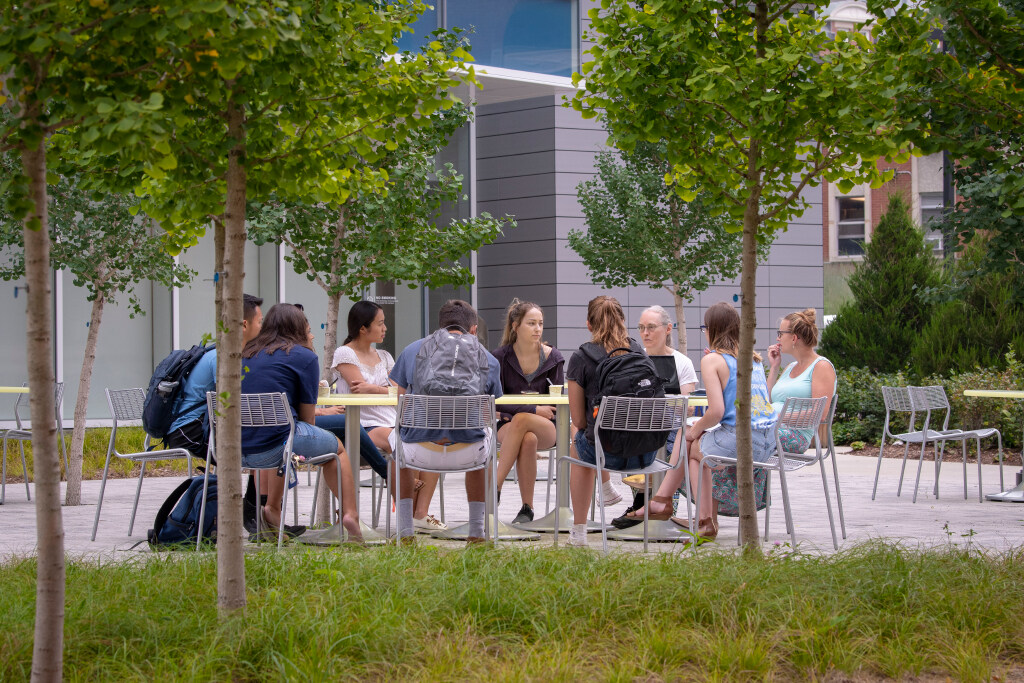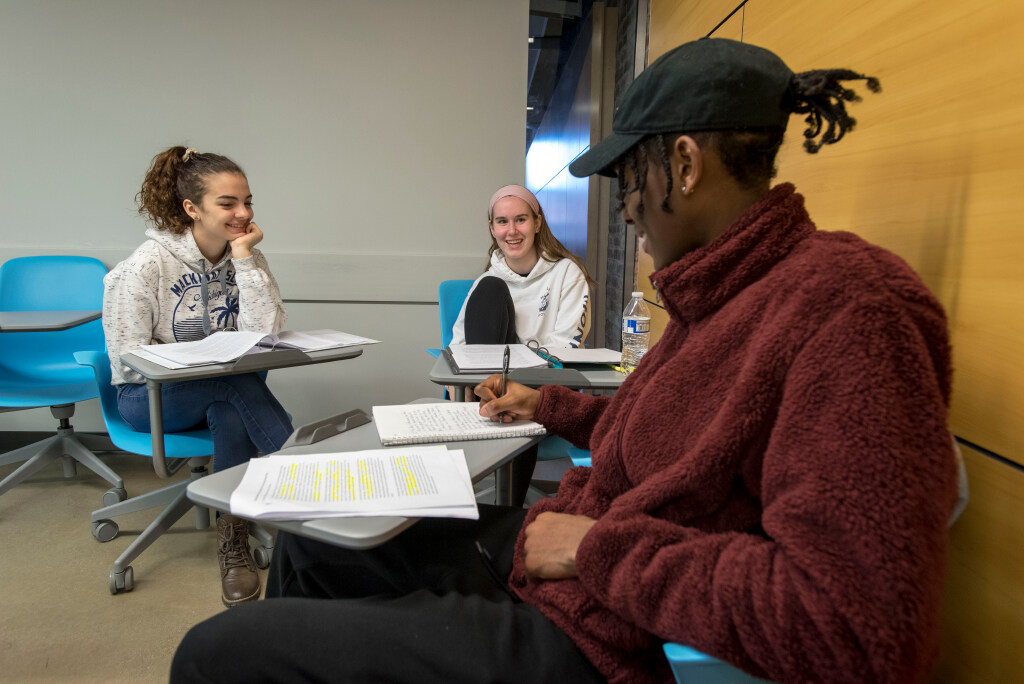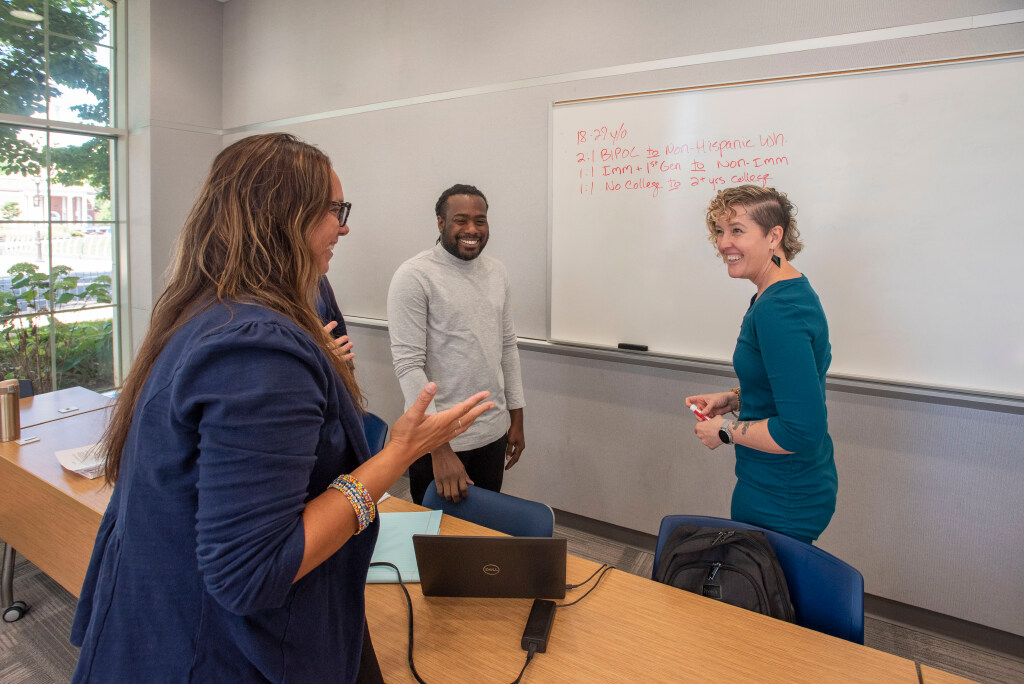Note: The information presented here is curated to support pedagogy and does not take the place of procedures required by the University’s Title IX office, ADA compliance office, Community Standards, Human Resources, the Graduate School, campus safety, or policies on workplace harassment and non-discrimination. In cases where violations relevant to those may have occurred, it is best to reach out to those offices for guidance.
Facilitating Challenging Conversations
First of all, if challenging conversations are happening because your course addresses inequities and social contexts for a subject or profession, congratulations for helping students see a bigger interpersonal and systemic picture and develop skills to navigate uncomfortable conversations that can lead to innovation and change. Doing this can feel risky, especially in the context of affective polarization, but there are ways to prepare for the conflict that may arise: design your course with intentionality to connect students to one another; and prepare intervention strategies for times when conflict erupts in your classes and labs. (Please keep in mind that it may occur in both synchronous and asynchronous classes, and in channels that students use outside of class. Establishing a culture of openness and trust can help you stay informed of such events.)
Challenging conversations—conversations that include emotional attachment to a perspective, or in which power and bias are exercised against others—occur regularly in classes and other academic spaces such as labs and offices. The suggestions here are made with a view to supporting instructors in undergraduate courses, primarily. Dynamics differ in small and large classes. What follows here may be most applicable in small to medium classes, but many recommendations can be adapted for large lectures. For a 1:1 consultation with a CETL staff member on any aspect of your course design or teaching, please reach out.
Designing your course with intentionality
Engaging in reflection and reflexive practice will help you identify things you can do to build a culture of openness and trust and set the tone from the beginning of the course.
- Examples of reflection would be spending five minutes after each class making notes on which activities went well and which ones did not.
- An example of reflexive practice would be introspection about how broader social and institutional contexts—and one’s own values, commitments, or positionality—shape instructor choices and class outcomes.
- Intentionality can be described as engaging in both reflective and reflexive processes.
A concrete way to design discussions with intentionality is to add a learning objective (LO) to your syllabus that describes the specific objectives or skills/abilities that discussions are intended to foster. Inform students of the purpose of discussing a topic, so that they can perceive its value. Check in with students at mid-semester to gather their perception of how the discussions are, or aren’t, supporting stated learning objectives.
Intentional design does not end with the publication of the syllabus. During the semester, get to know the interests and affinities of your students. This goal can be supported in medium to large classes through a survey. In smaller classes, you might have students create short memoirs around a theme related to the subject of the course.
Another common practice that supports intentionality is to establish ground rules. Some instructors co-create these rules, or guidelines, with students. The instructor explains that the purpose of the guidelines are to support open, brave inquiry while minimizing harm to others and repairing it when it occurs. When you have created ground rules, or guidelines, for the classroom, you can refer back to them when necessary and remind students of their agreement to those rules at the start of the course.
Examples of ground rules or agreements:
- Step up / step back – be aware of how much you’re talking. “Share the floor” (step back) or find a way to speak up if you have been silent (step up)
- Confidentiality – remember the lesson, not the name
- Take group work seriously
- Stay curious
- Refer to others by their stated pronouns if known
- Embrace discomfort as a part of learning
- Be open to hearing about impact as well as describing intent
You can write guidelines in many different ways. Here is another example:
| Listening: Listen behind what is said |
| Respect: Trusting the integrity of others; everyone has a right to her own opinion |
| Humility: Our side is not the side; others may have different information |
| Voice: Being comfortable asking questions about things we don't and/or understand |
| Trust: Work through conflicts, controversy and painful moments |
1Learning for Justice https://www.learningforjustice.org/professional-development/critical-practices-for-antibias-education-classroom-culture.
When developing ground rules, be aware that such rules often reflect norms of dominant positionalities (most often these are white, wealthy, cisgender, male, and heterosexual norms of communication) and foreclose cultural modes of expression or authentic discussions about social justice. In other words, avoid rules that predictably serve the comfort of those with the most power or privilege; for example, vague rules about respectfulness or calm. (See Sensoy and DiAngelo, 2014)
A fourth essential activity is to make time for students to reflect on the discussion. You might require a 60-second reflection at the end of class, which students turn in on paper or via HuskyCT (the journals tool works well for this).
The suggestions above also support formal dialogue. If you are interested in formal (or structured) dialogue in your class, contact CETL or the Democracy and Dialogues initiative at UConn. Basic guidelines for dialogue are described in the next section.
Designing for listening & dialogue skills
A shortcut way to think about success in dialogues is to think about agreements, structure, and intentions.
- Agreements may include things like class ground rules that you can refer back to
- Structure may include things like time limits on speakers, regular use of breakout sessions, and norms for calling on students or discussion participation
- Intentions refer to your own purposes for a dialogue or class session, and the clear articulation of that purpose to students; it may also include goals you co-create with students for a unit, a class meeting, or a specific discussion.(Essential Partners, whatisessential.org).
In Accountable Talk: Instructional dialogue that builds the mind, Resnick, Asterhan, and Clarke name three elements of what they call accountable talk: accountability to knowledge, accountability to reasoning, and accountability to community. The instructor’s role is to describe these forms of accountability in class discussions, and to:
- establish norms for discussion,
- signal the goals of class discussions,
- structure student engagement,
- facilitate, using sentence starters if necessary, and
- highlight when students make appropriate use of accountable talk norms.
Because class discussions are often treated as recitative—an opportunity for students to demonstrate comprehension of facts, concepts or solutions—dialogical models promise to implicate the practice of listening to perspectives to a greater degree than usual. If it seems relevant to your course learning objectives or to student preparation for future goals—and it probably is—remind students of the value of active listening. Even if you do not use dialogical structures, you might still include explicit instruction and practice in listening in one of your lesson plans. A commonly used exercise is to practice repeating a statement in the same words, repeating the message in paraphrase, and then re-stating the message in one’s own way; the listener checks in with the speaker after repeating, after paraphrasing, and after reflecting, to get confirmation that what they heard was what the speaker intended to convey.
1Imelda Bickham. File:Active-listening-chart.png. (2020, May 5). Wikimedia Commons.
You might recommend (and model) the value of silence.
This Active Listening handout from University of Adelaide.pdf describes five key behaviors of active listening, provides examples of sentence starters, and lists the benefits of active listening, which you can share with your students. (You might frame the benefits to both the listener and the speaker.) The framework described in the handout emphasizes copious paraphrasing by the listener. In contrast, constructivist listening, as in formal dialogue protocols, emphasizes opportunities to share perspectives and lived experiences without being paraphrased. The National Equity Project’s constructivist listening protocol acknowledges the need for expression-as-release of distressful feelings and tension prior to meaning-making. Its main benefit is to hold space for distress and hurt being expressed by a speaker, so that complex meaning-making can ensue. If you anticipate challenging discussions, you might give students a chance to practice this protocol, or you might familiarize yourself with it well enough to implement it when heated moments happen.
Note: Because debate has a long tradition in U.S. academic culture, it tends to be an unquestioned practice in college classrooms. This chart.jpg compares debate to dialogue, and may be useful as you plan your classroom activities.
For more suggestions on building a culture of trust, see Building Community and Brave Spaces as a Foundation for Equitable Classrooms.
Preparing for Challenging Discussions
Sometimes the instructor knows that certain class sessions will involve a greater degree of discomfort or conflict than others. Before these class sessions, take some time to visualize how the class will go. Intentional planning includes thinking about the purpose of the discussion, any roadblocks, intent versus impact, and how you will scaffold the discussion. For example, will you use a formal dialogue protocol?
A simple and effective teaching strategy is to build in time for students to gather their thoughts. Think-Pair-Shares and 60-second essays can reduce anxiety and support students reflecting on their intent and the possible impact of their words. Think-Pair-Share simply means that after you pose a question or task you allow some time for students to think before they turn to a partner to talk, after which you ask for a few of the pairs to share with the whole class. There are many varieties of small group work (dyads, groups with assigned roles, panels, etc.). Which of these structures will allow you to circulate and “read the room” in your specific course?
Part of your preparation might include designing worksheets (for example, in Google Docs), glossaries, timelines, sentence stems, or other kinds of templates to guide discussions. Worksheets can be complex or very simple, as in this Seed Discussion Organizer.pdf. (There are special considerations when teaching remotely.)
Whether or not the discussion explicitly takes up the topic of race, but especially if it does, this self-assessment.pdf from Teaching Tolerance will help you prepare by reflecting on your strengths and needs. ASCD has a toolkit to help you know what to expect and how to facilitate discussions about race. The Safe Zone Project offers resources for facilitating discussions about gender and sexuality.
Connecting Students across Difference
“Culture refers to a wide range of identity and community characteristics. Culturally responsive pedagogy engages identities and identity issues across all groups and communities: gender, ability/disability, religion, sexual orientation, socioeconomic status, race, ethnicity, language and nationality.” Learning For Justice.
In the context of political acrimony you may encounter heated moments during a class session. When heated moments arise, it is essential to engage in activities that help students communicate across difference in a way that is informed more by dialogue than debate. The instructor’s role in this is complex, and it is natural to want to avoid topics for fear of making a mistake. However, with awareness of how students from marginalized groups experience the climate at UConn, microaggressions, or discussions about specific topics, you can take steps to identify harms and address them in a way that protects students from further harm. With time spent on low-stakes icebreakers and sharing of personal experiences and values, relationships and cultural awareness can be built before the heated moments arise. Remember that in many cases, particularly for students who have been oppressed or marginalized because of their identit(y/ies), years of traumatic events and/or accumulated invalidation may be entering the classroom with your students. The way this shows up can vary from wisdom and maturity, to raw emotions, to disassociation and disengagement, to perfectionism.
The importance of compassion and trust cannot be overstated. Stephen Murphy-Shigematsu recommends eight practices to help connect students across diversity:
| 8 practices to connect students across diversity (Murphy-Shigematsu) | Application / examples |
| Foster mindfulness | Pause and ask students to check in with their breathing, sounds in the room, or the way a topic is impacting them somatically. Writing prompts and movement are other examples of exercises to foster mindfulness. |
| Honor vulnerability | Include content warnings on syllabus and give students a heads up about material that may cause distress.
Create pathway for students to give you feedback about how a discussion made them feel. Listen to their feedback. Teach the concept of intent versus impact, and common types of microaggressions. Share your own feelings of vulnerability. |
| Model authenticity | Tell a story about a mistake or failure on your part, and how it made you feel.
Consider the impact of respectability politics. |
| Practice listening | Project empathy through eye contact and other non-verbal cues.
Consider planning for a fishbowl exercise or other affinity group caucusing. Teach students how to listen actively. |
| Balance acceptance and change | Remind students that one conversation may not change anything, but may become one piece of a longer process of change. |
| Cultivate compassion | Encourage students to read or view stories with complex characters and practice interpreting the character’s actions through the lens of compassion.
In STEM classes, reserve time for perspective-taking. Ask students to describe a time when they have benefitted from compassion from others. |
| Focus on gratitude and appreciation | Thank students for their contributions to discussion.
Ask students to write a 60-second reflection at the end of every class describing one thing they appreciated or are grateful for. |
| Take responsibility | Remind students to use “I” statements when talking about opinions, experiences, and feelings.
Ask students to paraphrase the comments of other students, and challenge them on inaccuracies in the way they represent the other student’s views. |
Table 1 Eight practices to connect students across diversity, with examples
A one-on-one consultation with a CETL staff member can assist you to apply these principles within your specific teaching context.
Sometimes instructors lack confidence talking about difference because they are unsure of the kindest way to refer to identities. This glossary from The American Psychological Association may help. You might ask students how they prefer to be identified. In addition to honoring student experience, sharing your own experiences authentically can contribute to an anti-bias culture in a course. Model the practice of recognizing when you make a mistake and apologizing. Allow students to see you as a fellow inquirer even as you take the role of “multipartial facilitator” (Essential Partners, 2020). Reflect early and often upon how your own identities show up in interactions, and how they intersect with your identity as an instructor (reflexive practice). Cultural awareness, including awareness of historical and systemic patterns of oppression and privilege, will not only result in more inclusive or equitable courses; when encouraged in students it will form the basis of lifelong learning and invite significant growth in competencies required for individual success and an equitable and just future.
If you are interested in how mindfulness practices may support social justice pedagogy, the Association for Contemplative Mind in Higher Education offers this recorded webinar and this list of guided practices. The work of Rhonda V. Magee offers in-depth, guided practices in her book, The Inner Work of Racial Justice and short guided meditations videos on her website. These resources might inform an instructor’s preparation to teach, or might offer ideas for mindfulness practices students can engage in, to support connection and dialogue.
Facilitation and intervention in heated moments
This section does not address instances of physical violence, although these can and do occur among students at UConn, particularly sexual and gender-based violence. University faculty and staff are mandated reporters, so if you know about an incident, contact the Title IX office, who can address the situation or refer it to the appropriate office. At this time, CETL does not have guidance for intervention in physical altercations in classrooms, as these are extremely rare.
Although conflict is uncomfortable, heated moments can be a sign of, or at least provide an opportunity for, learning and engagement. Clashing perspectives provide opportunities to surface the values and commitments that students seldom have an opportunity to reflect on or question. Theatre Delta, a group that uses theatre pedagogy and facilitated discussions to examine bias and promote dialogue, created this handy one-page summary.pdf for making a quick decision when conversations get heated.
Online courses, or courses that include online components such as chat functions or discussion boards, require attentiveness to how heated moments may show up in these spaces. Make sure you moderate discussion boards, course journals, shared blogs, and chats. You may wish to disable the feature that allows students to send private chat messages to one another during an online class.
Not all heated discussions involve harmful comments, but they often do. A basic question you can ask yourself when a discussion becomes heated is, is now the right time to address it? If it is, then your next step is to slow down the conversation by creating a pause for reflection. Allow students some amount of time – perhaps 5 minutes – to reflect on their feelings before returning to the discussion. This can be freeform writing or using a template such as the seed discussion organizer. You might even lead students in simple mindfulness activity such as spending 30 seconds focusing only on the next three breaths, or other grounding activity. Somatic mindfulness (awareness of the body’s response to stress) might also include a two-minute body scan, a brief ambient-sound meditation, or allowing students to walk about. If you are not experienced in body-based mindfulness, this trauma-sensitive mindfulness practices webinar provides a crucial perspective.
If you cannot address it in the present moment, reassure your students that you will address it in a follow-up communication or in the next class.
Harmful comments such as stereotypes do not always result in heated discourse. Often they don’t, as students may elect not to engage with the perpetrator. While respecting this choice, instructors should plan to intervene, whether now or later. Do not let harmful remarks pass. One strategy in the moment is simply to state “that’s a stereotype” or “ouch.” Dialogue practices recommend asking “can you repeat what you said?” followed by “tell me how to came to hold that belief.” A meta-analysis by Derald Wing Sue, et al (2019), describes an extensive list of intervention strategies.
Understanding impact
Try to resist the urge to avoid a topic related to current events if it comes up in a way that seems to demand a response from you. Avoidance by the instructor can have a detrimental effect on students. Similarly, ignoring comments that disparage minoritized identities or ignores systemic racism, sexism, and other forms of oppression, harms students and erodes trust. While many students are quite resilient, the effects of avoidance on classroom dynamics, trust, and learning, are significant no matter what. Some students may be in circumstances that make them more vulnerable to bullying or self-harm. Research also shows that some students are less likely to seek mental health help. These are two reasons why instructors are urged to inform students of campus resources such as Student Health and Wellness (SHaW) and the Office of Institutional Equity (OIE) on their syllabi.
In this section you will find information on the importance of social connections and emotions in learning, as well as resources for understanding common experiences of students who are frequently marginalized and/or oppressed because of their identit(y/ies), including racial battle fatigue, microaggressions, and trauma.
Understanding intent vs impact (Fatima Dainkeh)
5 examples of how your support for Black lives (or lack thereof) may be causing harm
Recognizing Microaggressions
According to a 2021 survey, more than one-third of UConn students have experienced microaggressions in the classroom, and many more have done so in other campus spaces such as dormitories. There is growing evidence that these experiences can limit cognitive processing speed. Cumulative experiences of slights can result in harms to mental health. To protect their well-being, some students elect to leave higher education environments, their degree programs, and their educational goals. For this reason, instructors who grow their emotional intelligence about microaggressions will be in a better position to teach all students.
When something happens, it may be obvious or there may only be a subtle shift in the nonverbal behavior of the students in the room. You may sense discomfort. Whether it’s overt or subtle, it is very important to name what you heard or sense. This may include apologizing sincerely when you, the instructor, say something that resembles a microaggression. You might explain to students that microaggressions are grounded in the widespread, unavoidable socialization we receive as long as systemic white supremacist, ableist, heteronormative, gender normative, patriarchal, ageist, and classist ideologies continue to circulate, but that bringing awareness can shift relationships and climate for the benefit of learning and growth.
To recognize moments that require intervention, familiarize yourself with forms of microaggressions, particularly if you have limited experience with them. The video by Yolanda Flores Niemann and students at the University of North Texas provides an excellent overview with examples of micro-assaults, microaggressions, and microinvalidations, and their impact.
Microaggressions in the classroom, by Yolanda Flores Niemann (18-min. video)
Originally coined by Harvard sociologist Chester Pierce in the 1970s, the term “microaggression” became widely used after Derald Wing Sue advanced and updated its framework. Sue defines the term as “the everyday slights, indignities, put downs and insults that people of color, women, LGBT populations or those who are marginalized experience in their day-to-day interactions with people" (2010). Sue’s original taxonomy of ten types has since been expanded by Monnica Williams, et al, to include 16 categories of microaggressions that have been described in research studies focusing on race and ethnicity. Notably, the expanded list includes acknowledgement of the ways that emotional responses by white people to the discomfort of being challenged on matters of race frequently occasion the kinds of statements and behaviors known as microaggressions. Understanding reactions students who are white (or belong to other dominant identities such as cisgender, straight, male, and able-bodied) have can help instructors prepare for the possibility of harmful comments—and learning opportunities.
Microaggressions that target LGBTQ+ individuals are described here.
Check out this booklet by Juan Garibay for more context and description of common verbal and nonverbal behaviors that are often experienced as microaggressions; this chart from UC Berkeley; and this article, which describes in more detail the harmful impact that can occur to students of marginalized identities.
Racial Battle Fatigue
The term racial battle fatigue was coined by William Smith to describe the psychological stress response.pdf, particularly among Black men in the United States, to repeated experiences of overpolicing, microaggression, surveillance, and other forms of delegitimation or violence. This term, as well as race-related stress and cultural taxation (Padilla), has been used to describe the effect of cumulative racial slights in workplaces and educational institutions. Students at UConn report regular experiences of microaggressions and microinvalidations, including in the classroom, and it can be surmised that racial battle fatigue is a common condition among Black and brown students. The experience of oppression based on multiple marginalized identities (for example, being a Black person who is gay) exacerbates the effects.
If you are an instructor of color, increased demands for emotional labor, and service to the University on questions of diversity, equity, and inclusion, can lead to “racial battle fatigue,” or burnout, as can hypervigilance. BIPOC instructors at the University report that students frequently question their authority, and bias in student evaluations of teaching, well-documented in pedagogy literature, adds to psychological stress. You might also experience a drain on your energy levels from horizontal oppression and/or the pressure to avoid talking about your experiences in order to maintain the comfort of white colleagues.
These experiences of students of color and instructors of color constitute expenditures of energy and added cognitive load. Being aware of this cumulative impact is an important part of strengthening relationships with students, achieving overall equity goals, and self-care. In practice, it is seldom appropriate to speculate about an individual student’s race-related stress unless the student approaches you, or you have established rapport with that student. Nonetheless, sensitivity to racial battle fatigue should inform an instructor’s facilitation of class and interpretation of small group dynamics.
Resources for self-care for Black, Indigenous, and People of Color (Harvard U.)
Understanding racial battle fatigue
Strategies for practicing self-care from racial battle fatigue (Quaye et al)
Trauma-informed Pedagogy and Healing-centered Pedagogy
Emotions and social factors are not extraneous to learning. Even in courses that do not center discussion, a student’s interactions shape the circumstances for learning in a course. Contemporary bureaucratic structures at complex institutions such as universities can be challenging to navigate on top of one’s academic studies; the challenge is compounded by microaggressions. While instructors may interact with students only in class time or office hours, it is important to recognize that the whole of the student experience will impact their well-being and their ability to learn—and to progress through a degree over time. Racism, homophobia, religious bigotry, and ableist exclusion sometimes result in overt incidents on campus, but are insidiously present in ordinary ways, too, as described in research on microaggressions. Exclusion, invalidation, and stereotyping have cumulative emotional and physical effects over time (Menakem).
Trauma-informed pedagogy does not claim diagnostic power; rather, it is a shorthand way to recognize the impact of even vicarious traumatic events on the learning mind and body.
When preparing for difficult dialogue, these frameworks for trauma-informed pedagogy may help you design your approach in a way that is more inclusive than many traditional teaching paradigms. For example, consider whether your teaching practices can employ one of these concepts:
- heartfulness(Murphy- Shigematsu)
- soul-centered teaching (Harrell)
- creativity to mitigate stress (Aguilar)
- healing-centered perspectives (see, e.g., Ginwright; Menakem)
- making space for creative expression, joy, and community connection
- encourage community building.
Healing-centered approaches may also involve finding ways to teach resistance history. Interrogating whiteness, homophobia, ableism, and structural inequity can be liberating and support healing for all—provided it is properly scaffolded. Self-reflection may be a precondition for such work, of course, and there are many resources available on the internet, in books, and among colleagues engaged in liberatory teaching.
Teaching histories of resistance should accompany any lessons that include disparaging depictions or traumatic content. Before showing violence perpetrated against bodies of color or people targeted for violence because of their identities, reflect on whether the content is necessary to achieve specific learning objectives, and always provide content warnings on your syllabus and before the class session that includes such images. Consider allowing students to opt out and achieve the learning objective in a different way. Research on consumption of images of violence, such as on social media, can result in vicarious and cumulative trauma over time, particularly for students who share the identities of the targets of violence (Hawkins 2022; Mahamid 2020; Macy et al 2023; see also Sontag, 2003).
As necessary and useful as trauma-informed teaching practices are, trauma should not be the only lens through which students are viewed, especially if it takes on tinges of a deficit model. Getting to know students as individuals is important, to avoid making incorrect and harmful attributions and assumptions.
With some preparation for responding to emotion and channeling it productively, instructors can gain confidence that the challenging conversations they facilitate won’t become the proverbial “road to nowhere.” This planning tool.pdf from Learning for Justice is organized by the kinds of emotions you may encounter in the classroom from time to time, and offers some strategies. It is critical to avoid deficit ideology (Gorski, 2010). When engaging with trauma-informed pedagogy and social and emotional learning (SEL), avoid one-dimensional application, which can often perpetuate inequity and harm. For example, declaring that a student can, individually and solely, determine their success (through, e.g., “grit”), sends the erroneous message that structural factors have nothing to do with a student’s challenges. What is more, SEL models have unfortunately been misused for purposes of control (Kaler-Jones, 2020) of students of color.
Effects of social threat on the brain and learning (National Equity Project)
Trauma informed teaching (30-minute podcast by Angela Watson)
A student is not their trauma (Shawn Ginwright)
Avoiding deficit thinking as an instructor (Dena Simmons)
General principles of trauma-informed teaching and learning.pdf
White-body supremacy as a trauma response (Resmaa Menakem)
References
Hawkins, Deion S. (2022) “After Philando, I Had to Take a Sick Day to Recover”: Psychological Distress, Trauma and Police Brutality in the Black Community, Health Communication, 37:9, 1113-1122, DOI: 10.1080/10410236.2021.1913838
Mahamid, F. A., & Berte, D. Z. (2020). Portrayals of Violence and At-Risk Populations: Symptoms of Trauma in Adolescents with High Utilization of Social Media. International Journal of Mental Health and Addiction, 18(4), 980–992. https://doi.org/10.1007/s11469-018-9999-0
Fleckenstein, K. S., Gage, S., & Bridgman, K. (2017). A Pedagogy of Rhetorical Looking: Atrocity Images at the Intersection of Vision and Violence. College English, 80(1), 11–34.
Macy, Marisa, Maria P. Spinetti Rincon, Robert Macy, Bingbing Zhang, “Social Emotional Sequelae Resulting from Trauma Experienced by Media Exposure in the Early Years: Implications for Policies and Practices.” The International Journal of Humanities Education ISSN: 2327-0063 (Print), ISSN: 2327-2457 (Online) Volume 21, Issue 2, 2023 https://doi.org/10.18848/2327-0063/CGP/v21i02/59-74
Sontag, S. (2003). Regarding the pain of others (1st ed.). Farrar, Straus and Giroux.
References
Gorski, Paul. “Unlearning deficit ideology and the scornful gaze: Thoughts on authenticating the class discourse in education” Counterpoints, 02 (2010):152 – 173
Kam, Brandt, Hadrian Mendoza, and Akihiko Masuda. “Mental Health Help-Seeking Experience and Attitudes in Latina/o American, Asian American, Black American, and White American College Students.” International Journal for the Advancement of Counselling 41 (2019): 492-508.
Kaler Jones, Cierra “When SEL is used as another form of policing” The Medium Blog. (May 7, 2020) https://medium.com/@justschools/when-sel-is-used-as-another-form-of-policing-fa53cf85dce4
Resnick, Lauren B., Christa S.C. Asterhan, and Sherice N. Clarke. Accountable Talk: Instructional dialogue that builds the mind. Educational Practices Series 29 (2018). Paris: UNESCO International Bureau of Education.
Sensoy, Özlem., and Robin DiAngelo. Respect Differences? Challenging the Common Guidelines in Social Justice Education. Democracy & Education, Vo. 22, no.2 (2014).
Williams, Monnica T., Matthew D. Skinta, and Renée Martin-Willett. “After Pierce and Sue: A Revised Racial Microaggressions Taxonomy.” Perspectives on Psychological Science 16, no. 5 (2021): 991–1007.
Additional resources
Facilitating challenging conversations in the classroom (Washington U St. Louis)
Guidelines for discussing difficult or high-stakes topics (U Michigan)
Difficult Dialogues (Vanderbilt U.)
Navigating difficult moments (Bok Center at Harvard U)
How to Encourage Respectful Discord in your Classroom (Harvard Business Publishing)
Quick Links
![]()
Consult with our CETL Professionals
Consultation services are available to all UConn faculty at all campuses at no charge.








